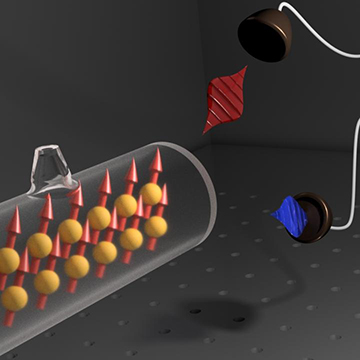
In the hybrid bipartite entanglement scheme of the Polish team, a single photon (blue) is correlated, or entangled, with an atomic spin-wave excitation inside quantum memory glass cell. A subsequent detection process, using a second photon (red) after a time delay, confirms the entanglement. The setup enables demonstration of the Einstein-Podolsky-Rosen paradox with true positions and momenta. [Image: University of Warsaw Physics/Michal Dabrowski]
A group of researchers from the Institute of Experimental Physics at the University of Warsaw, Poland, has demonstrated robust, 12-dimensional entanglement between a single photon and a suite of a trillion hot rubidium atoms, storing the entangled state for lengthy 6 microseconds (Optica, doi: 10.1364/OPTICA.4.000272). The feat—a tour-de-force of measurement resting in particular on a highly sensitive, custom-developed CMOS single-photon camera—has potential applications in quantum information processing. It also once again offers a real-world example of one of the most celebrated paradoxes in quantum physics.
EPR, noch einmal
The paradox in question, of course, is the Einstein-Podolsky-Rosen (EPR) paradox, a thought experiment framed in 1935 by Albert Einstein, Boris Podolsky, and Nathan Rosen. In essence, the EPR argument held that in the case of the spontaneous decay of a particle into two subparticles traveling in exactly opposite directions (i.e., with correlated positions and anti-correlated momenta) one could, in principle, measure the position of one particle and the momentum of the other, and thus know the position and momentum of both particles with arbitrary precision—in violation of Heisenberg’s uncertainty principle.
Einstein and his colleagues believed that this paradox undermined the so-called Copenhagen interpretation of quantum mechanics, and that quantum theory was thus still incomplete. Many hundreds of experiments later, however, it’s become clear that the EPR “paradox” is not a paradox at all—that the supposedly impossible nonlocal connections described in the EPR thought experiment are in fact a fundamental part of real-world quantum systems, the phenomenon of quantum entanglement. And, when the multipart system is rolled into a single quantum wavefunction, nonlocal interactions are permitted without violating the Heisenberg equation for the system as a whole.
In photonics in particular, EPR-entangled states of light, and of light and matter, have been repeatedly demonstrated in recent years, and have, indeed, emerged as an important resource in developing quantum information and cryptographic systems.
Memory cell
The Polish researchers wanted to see how far they could push EPR entanglement in a hybrid system. To do so, they set up a 10-cm-long, glass quantum memory cell vacuum cell containing approximately a trillion Rb atoms at a temperature of 75°C, diffused through the cell. They then fired a driving laser into the mix. Spontaneous Raman scattering created a series of entangled pairs with anticorrelated momenta, consisting of a single Stokes photon and the spin-wave excitation state of the entire atomic ensemble. A subsequent laser pulse, sent through at a specific delay time, was used to convert the atom ensemble’s spin-wave excitation into a second, anti-Stokes photon, allowing “readout” of the ensemble’s spin-wave state.
The team captured individual scattered photons on a state-of-the-art, single-photon-sensitive camera developed in the lab. By measuring and comparing the position and momenta of separate Stokes and subsequent anti-Stokes photons in the near and far fields, were able to confirm EPR entanglement between each Stokes photon and the spin-wave excitation of the entire ensemble of atoms. And, in analyzing the anti-Stokes photon in particular, the researchers found that they could store the initial entangled state in the atom ensemble within the memory cell for an “unprecedented” 6 microseconds—a very long time in quantum-mechanical terms.
Toward “hyperentangled” states
That long storage time could, in the view of the research team, hold promise for applications in quantum information processing. The group points out that the quantum memory cell can store the state of up to 12 photons at once. And, noted group leader Wojciech Wasilewski in a press release, “the multidimensional entanglement is stored in our device for several microseconds, which is roughly a thousand times longer than in any previous experiments.” That, he says, is a time scale “long enough to perform subtle quantum operations on the atomic state during storage.”
Indeed, the researchers point out that combining this result with entanglement in other degrees of freedom, such as polarization, could allow the generation of “hyperentangled” states, and could raise boost the prospects for so-called EPR steering—the practical ability to affect one nonlocal system’s behavior by local measurements in another system. Such an ability could prove quite handy in information applications such as quantum key distribution.
